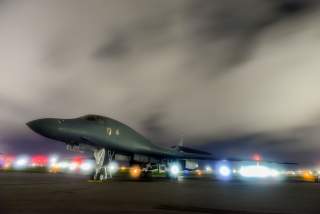Keep U.S. Nuclear Options Open to Avoid Using Them
Further constraining America’s nuclear options would weaken deterrence.
In any conflict, the primary nuclear threshold can only be crossed once. Demonstrating a credible means of going second in no way implies greater willingness to go first. Furthermore, while the U.S. threshold for first use should be very high, the threshold for contemplating a nuclear response in kind should be low. Adversaries should believe that any nuclear attack on the United States or its allies might elicit a nuclear response. Possessing options that help make a U.S. nuclear response to nuclear attack look plausible and credible is a good thing. As the NPR finds, raising adversaries’ nuclear threshold in this way makes the actual execution of any nuclear option less likely.
Another argument raised against expanding or even sustaining U.S. nuclear options is that the range of options already available is more than sufficient. According to William Perry and Tom Collina, “We already have low-yield nukes . . . If the president really ever needed to use a low-yield nuke, he has plenty.” Similarly, Hans Christensen concluded that foreseeable deterrence challenges “can be address [sic] with the considerable capabilities in the current nuclear arsenal.” To underscore, Christensen created a map showing the Russian homeland dotted with “hypothetical aimpoints for 1,000 low-yield warheads.”
These statements mischaracterize nuclear options as the ability to choose between one weapon and its identical twin, without respect for limitations of the entire family. They are akin to arguing that acquiring a canoe to cross a river is unnecessary if one can already choose from among a whole fleet of bicycles. Congressional funding for a low-yield ballistic missile has nothing to do with obtaining greater numbers of low-yield weapons or multiplying choices between functionally equivalent ways of destroying a target. In fact, there is nothing in the NPR about needing greater numbers of weapons. Instead, this funding provides a unique prompt capability and ensures that an adversary who figures out how to defeat U.S. bombers has not negated the entire U.S. ability to respond and therefore to deter with low-yield nuclear weapons.
Sustaining Nuclear Options Is Still Good Policy
In today’s challenging and uncertain security and technology environments, there is no space for further constraining America’s nuclear options without weakening deterrence. The United States must now take discrete steps to preserve flexibility within its deterrent forces. Nuclear options provide and preserve key attributes that remain critical to keeping deterrence effective and stable. The Obama and Trump administrations have done the hard work of designing a nuclear modernization plan that sustains a deliberate range of options into the future. Success will require executing through multiple decades, administrations and Congresses. The greatest overall risk is in failing to follow through at a time when America’s nuclear deterrent capabilities will age into obsolescence unless replacement programs proceed on schedule. The United States cannot allow this failure, because sustaining nuclear options is critical to preventing nuclear conflict.
Dr. Aaron Miles is a fellow at the Center for Global Security Research at Lawrence Livermore National Laboratory. He served previously as assistant director for Nuclear and Strategic Technologies at the White House Office of Science and Technology Policy, and as a Senior Policy Advisor on Nuclear Deterrence in the Office of the Secretary of Defense. His policy interests include nuclear strategy, strategic stability, and arms control.
Lawrence Livermore National Laboratory is operated by Lawrence Livermore National Security, LLC, for the U.S. Department of Energy, National Nuclear Security Administration under Contract DE-AC52-07NA27344. Image: Reuters

